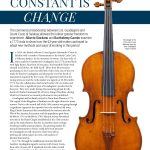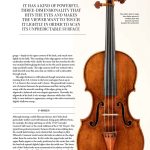Erminio Montefiori was born in La Spezia, a town on the border of Liguria and Tuscany, on 11 January 1841. In 1853 his father, a shoemaker, moved his family to Genoa, where Erminio soon became a skilled sculptor. He started to dedicate himself to violin making from at least 1883, when he gained a medal ‘for ability in violin restoration’ at that year’s Industrial Exhibition. In 1892 he participated in Genoa’s Italo–American exhibition and in 1894 in the Milan International Exhibition. In 1903 he moved to Marseilles where he died a year later. It seems that Montefiori always worked alone and had no pupils. A self-taught luthier, he had a personal and free approach to violin making: his experience as a sculptor can be seen in the fast and confident carving of his scrolls. He often made use of models taken from 18th-century Genoese makers (quite an eccentric thing in those times) and as a re-sult his instinctive approach to violin making led him to produce instruments that always have an antique look, as with the 1892 violin shown here.
F-Holes
The model for the f-holes is of personal inspiration. There was no drilling for the upper and lower eyes, with the cut undertaken with a knife only. It looks fast and a little careless; the fluting of the flanks is quite deep and a little flatter on the lower wings. The nicks are small and delicate.
Archings
The archings are well scooped in the C-bouts and around the edges, and quite flat in the central area. Both front and back are 14.5mm high.
Purfling
The thickness is about 1.4mm, equally divided into three strips of hardwood (probably maple) with the ‘black’ stained with a deep dye. It is set at 3.8mm from the edges and knife cuts are visible in many places along the contour; the corners have no bee-stings.
Scroll
Cut with great confidence and skill,
the scroll evinces Montefiori’s strong personality and natural talent. The model comes from the 18th-century Genoese maker Giuseppe Cavaleri, with a small, well-rounded eye in the side view: the cut is quite deep and a few marks of a small gouge are visible in the turns. In the front and rear view the pegbox is well tapered, the channelling well scooped and gently finished.
Interior
The interior work shows no evidence of the use of a mould. It seems very likely that Montefiori enjoyed a free and fast approach to the whole making process and a certain disregard for a clean result. The sides are quite low, especially at the end-button (28.3mm), the corner-blocks are made of lime wood and the linings of wide-grained spruce, simply set on the blocks. The top- and bottom-block are made of pine, according to the 18th- century Genoese tradition of using different woods from the corner-blocks.
Varnish
The varnish is of a good consistency and texture, laid on a ground that enhances the grain of a light-figured slab-cut maple. From the 1894 Milan Exhibition guide we know that Montefiori was selling bottles of his varnish there.
Copyright © 2022 Alberto Giordano, The Strad magazine All rights reserved






